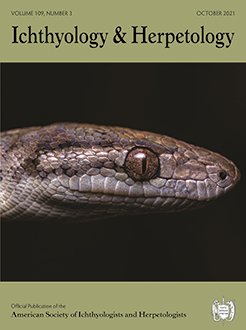A new genus and two new species of Indo-Pacific clingfishes are described in this study. The new genus, Flabellicauda, belongs to the Diademichthyinae and can be distinguished from other genera currently placed in this subfamily by the following combination of characters: snout moderate in length and slightly pointed, not extremely long or strongly rounded; oral cleft very small, restricted to anterior tip of snout, posterior portion of both jaws covered by thick skin of snout; gill opening a tiny, narrow slit, dorsalmost point level with base of 9th to 14th (usually 12th, rarely 9th) pectoral-fin ray in lateral view; gill membrane attached to isthmus; two rows of gill filaments on gill arches 1–3; extremely small “single” adhesive disc, its length 8.1–13.5% SL; center of disc flat, without cavity; disc papillae flattened, similar in size across disc surface; preopercular lateral-line canal and associated pores absent; dorsal, anal, and caudal fins connected via thin membrane, giving appearance of single, continuous median fin around posterior part of body; and upper and lower hypural plates completely fused, forming large fan-like hypural complex. Two new species are described and assigned to Flabellicauda, new genus, including F. alleni, new species (type species of Flabellicauda, new genus), and F. cometes, new species. Two additional species previously assigned to Lepadichthys are transferred to Flabellicauda, new genus, including F. bolini, new combination, and F. akiko, new combination. Among species of Flabellicauda, new genus, F. akiko is unique in having the following characters: head sensory canal pores poorly developed, including 1 nasal and 1 postorbital pore (vs. usually 2 nasal, 2 lacrimal, and 2 postorbital pores in F. alleni, new species, and F. bolini; 2 nasal pores in F. cometes, new species); upper end of gill opening level with base of 9th or 10th pectoral-fin ray in lateral view (vs. 12th to 14th); disc region A with papillae at center (vs. disc region A without papillae at center); and body background color red in life, with white stripes along body (vs. body background color black or maroon in life, with white stripes along body). Although F. alleni, new species, is very similar to F. bolini, the former differs from the latter in having a higher number of gill rakers (viz., 5–8 [modally 6, rarely 5], 6–8 [6], and 6–8 [7] on the first, second, and third gill arch, respectively, and 18–24 [19] total gill rakers [first + second + third arch] in F. alleni, new species, vs. 4–6 [5] on the first, second, and third arch, respectively, and 12–17 [14] total gill rakers in F. bolini). In addition to the meristic difference, head length, pre-disc length, orbit diameter, and caudal-peduncle length and width proportions further aid to distinguish F. alleni, new species, from F. bolini. Examined specimens of F. alleni, new species, were collected from Sri Lanka and southeast Asia, whereas those of F. bolini were collected from Papua New Guinea, Vanuatu, and Fiji; the range of the two species are not known to overlap. Flabellicauda cometes, new species, can be easily distinguished from F. alleni, new species, and F. bolini in having the following characters: 10–12 dorsal-fin rays (vs. 12–15 [13]); 9–11 anal-fin rays (vs. 10–13 [11], rarely 10); head sensory canal pores poorly developed, including 2 nasal and 1 postorbital pores. Notes on the ecology of each of the four species of Flabellicauda, new genus, are also provided.
How to translate text using browser tools
10 September 2021
Description of a New Genus and Two New Species of Indo-Pacific Clingfishes (Gobiesocidae: Diademichthyinae) with Redescription and Reassignment of Two Species Previously Assigned to Lepadichthys Waite, 1904
Kyoji Fujiwara,
Kevin W. Conway,
Hiroyuki Motomura





